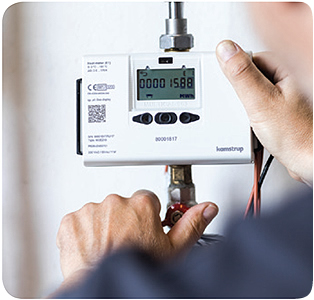 The obligation for EU countries to implement remotely read heat meters is a prerequisite for providing consumers with the necessary insight to encourage more energy efficient behaviour. But it is also a critical element in developing the position of district heating as a key technology to support decarbonisation and a sustainable energy future.
The obligation for EU countries to implement remotely read heat meters is a prerequisite for providing consumers with the necessary insight to encourage more energy efficient behaviour. But it is also a critical element in developing the position of district heating as a key technology to support decarbonisation and a sustainable energy future.
Ambitious EU strategy and legislation is paving the way for more district heating and an increased share of renewable energy. The two are closely linked, because district heating provides the necessary flexibility to integrate, utilise and store fluctuating energy from renewables ultimately increasing the efficiency of the entire energy system and decarbonising today's fossil-fuelled buildings. However, this remains a complex task that necessitates digitalisation of the sector.
The digital utility
As part of the revised Energy Efficiency Directive (EED), the requirement to install only remotely read smart meters for heat consumption became effective as of October 25th, 2020. While its original driver is to empower consumers by making monthly consumption data available to them, there are also clear benefits to be reaped by utilities ready to embrace the digital transformation that smart metering prompts.
Once the meters are installed, the additional expense for a utility to collect daily or even hourly data is minimal compared to the added value from adopting a more holistic digitalisation approach to its entire value chain. Three overall areas stand out: daily operations, asset management and end-user involvement.
Improving daily operations
Smart metering provides the basis for utilities to make fact-based decisions related to the daily operations surrounding their core tasks of producing and distributing district heating.
These include optimising the production and forward temperature to run closer to the limit, detecting heat and water loss in the distribution network as well as identifying improvement opportunities for building performance and consumer behaviour decreasing the overall system efficiency. This is all also crucial to achieving the right conditions and low temperatures to integrate more renewables.
Optimising asset management
Frequent meter data – as opposed to theoretic models – enable utilities to monitor the performance of the underground pipes that make up the distribution network.
This allows better utilisation and renovation planning of existing assets so utilities can potentially avoid or defer some of the heavy investments in this area. Also, being able to compare the actual network load and capacity to its design criteria will reveal how well they match. In this way, utilities can both extend the current infrastructure's lifetime and optimise dimensioning and planning of new networks to avoid expensive oversizing.
Enhancing end-user involvement
District heating is sometimes perceived as old-fashioned, monopolistic and fossil-fuelled. Ironically, this misconception stems from the very basis for its great convenience and efficiency: one system for all that is reliable to the extent of being virtually invisible. Consequently, access to consumption data alone is unlikely to trigger significant behavioural changes.
Digitalisation can help utilities make district heating more attractive to consumers. This could include offering targeted services such as billing based on flexibility, or taking responsibility for the heat installation, but also emphasising how it e.g. utilises waste heat from local supermarkets to heat up houses in the community. In this way, end users themselves become part of the shared story of a green, flexible and sustainable energy future.
More information
Web: kamstrup.com